Onkyo HT-R510 User Manual
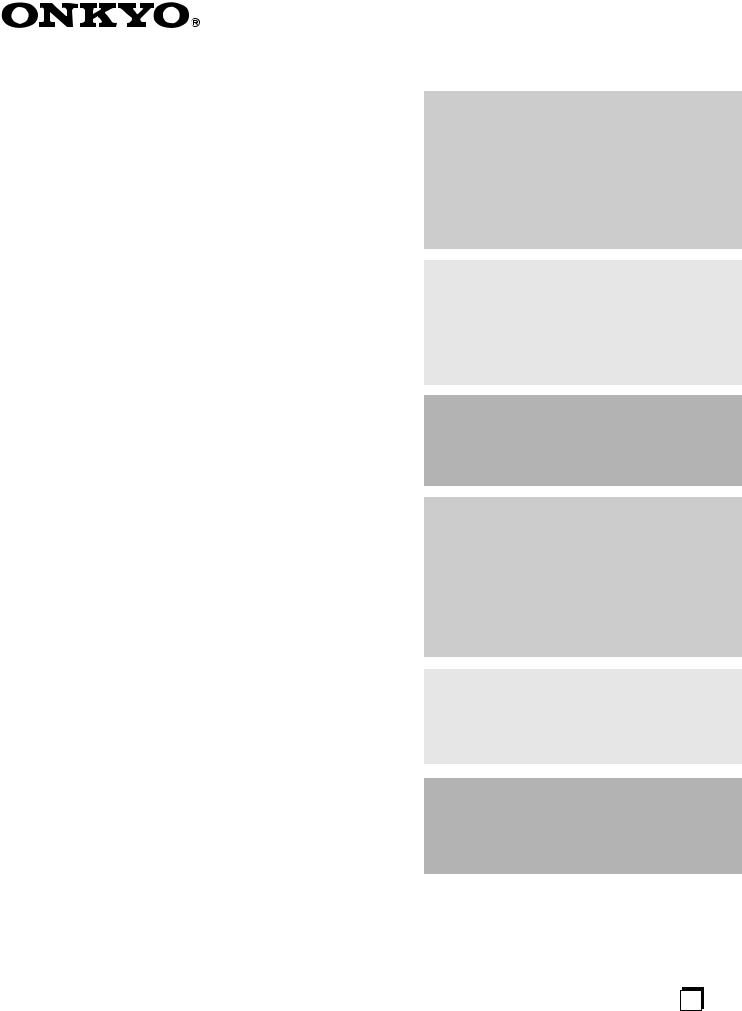
AV Receiver
HT-R510
Instruction Manual
Thank you for purchasing the Onkyo AV Receiver. Please read this manual thoroughly before making connections and plugging in the unit.
Following the instructions in this manual will enable you to obtain optimum performance and listening enjoyment from your new AV Receiver.
Please retain this manual for future reference.
Contents |
|
Introduction |
|
Important Safeguards................................................ |
2 |
Precautions................................................................ |
3 |
Supplied Accessories ................................................ |
4 |
Features..................................................................... |
4 |
Before Using the HT-R510....................................... |
5 |
Controls & Connectors ............................................. |
6 |
Connections |
|
Connecting Your AV Components......................... |
10 |
Connecting -compatible AV Components.............. |
19 |
Installing Your Speakers ........................................ |
20 |
Connecting Antenna ............................................... |
22 |
Setup |
|
Powering Up & Setting Up the HT-R510 .............. |
24 |
Configuring Speaker Set A..................................... |
25 |
Operation |
|
Playing Your AV Components............................... |
28 |
Using the Tuner ...................................................... |
30 |
Common Functions................................................. |
32 |
Using the Listening Modes..................................... |
34 |
Audio Adjust Functions.......................................... |
37 |
Recording................................................................ |
39 |
Remote Controller |
|
Using the Remote Controller RC-518M with Your |
|
Other AV Components........................................ |
40 |
Appendix |
|
Troubleshooting...................................................... |
44 |
Specifications.......................................................... |
47 |
En
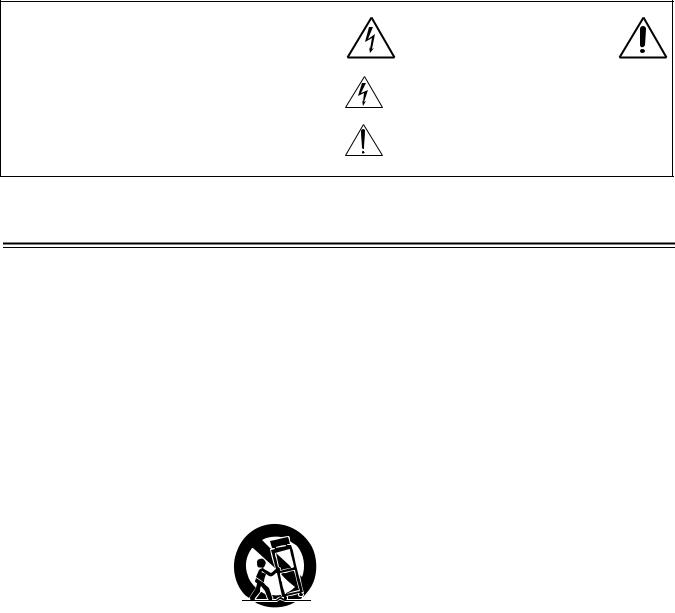
WARNING:
TO REDUCE THE RISK OF FIRE OR ELECTRIC SHOCK, DO NOT EXPOSE THIS APPLIANCE TO RAIN OR MOISTURE.
CAUTION:
TO REDUCE THE RISK OF ELECTRIC SHOCK, DO NOT REMOVE COVER (OR BACK). NO USER-SERVICEABLE PARTS INSIDE. REFER SERVICING TO QUALIFIED SERVICE PERSONNEL.
WARNING |
|
AVIS |
RISK OF ELECTRIC SHOCK |
|
RISQUE DE CHOC ELECTRIQUE |
DO NOT OPEN |
|
NE PAS OUVRIR |
|
|
|
The lightning flash with arrowhead symbol, within an equilateral triangle, is intended to alert the user to the presence of uninsulated “dangerous voltage” within the product’s enclosure that may be of sufficient magnitude to constitute a risk of electric shock to persons.
The exclamation point within an equilateral triangle is intended to alert the user to the presence of important operating and maintenance (servicing) instructions in the literature accompanying the appliance.
Important Safeguards
1.Read Instructions—All the safety and operating instructions should be read before the appliance is operated.
2.Retain Instructions—The safety and operating instructions should be retained for future reference.
3.Heed Warnings—All warnings on the appliance and in the operating instructions should be adhered to.
4.Follow Instructions—All operating and use instructions should be followed.
5.Cleaning—Unplug the appliance from the wall outlet before cleaning. The appliance should be cleaned only as recommended by the manufacturer.
6.Attachments—Do not use attachments not recommended by the appliance manufacturer as they may cause hazards.
7.Water and Moisture—Do not use the appliance near water –for example, near a bath tub, wash bowl, kitchen sink, or laundry tub; in a wet basement; or near a swimming pool; and the like.
8. Accessories—Do not place the appliance on an unstable cart, stand, tripod,
bracket, or table. The appliance may fall, causing serious injury to a child or
adult, and serious damage to the appli-
ance. Use only with a cart, stand, tri-
pod, bracket, or table recommended by S3125A the manufacturer, or sold with the
appliance. Any mounting of the appliance should follow the manufacturer’s instructions, and should use a mounting accessory recommended by the manufacturer.
9.An appliance and cart combination should be moved with care. Quick stops, excessive force, and uneven surfaces may cause the appliance and cart combination to overturn.
10.Ventilation—Slots and openings in the cabinet are provided for ventilation and to ensure reliable operation of the appliance and to protect it from overheating, and these openings must not be blocked or covered. The openings should never be blocked by placing the appliance on a bed, sofa, rug, or other similar surface. The appliance should not be placed in a built-in installation such as a bookcase or rack unless proper ventilation is provided. There should be free space of at least 8 in. (20 cm) and an opening behind the appliance.
11.Power Sources—The appliance should be operated only from the type of power source indicated on the marking label. If you are not sure of the type of power supply to your home, consult your appliance dealer or local power company.
12.Grounding or Polarization—The appliance may be equipped with a polarized alternating current line plug (a plug having one blade wider than the other). This plug will fit into the power outlet only one way. This is a safety feature. If you are unable to insert the plug fully into the outlet, try reversing the plug. If the plug should still fail to fit, contact your electrician to replace your obsolete outlet. Do not defeat the safety purpose of the polarized plug.
13.Power Cord Protection—Power-supply cords should be routed so that they are not likely to be walked on or pinched by items placed upon or against them, paying particular attention to cords at plugs, convenience receptacles, and the point where they exit from the appliance.
14. Outdoor Antenna Grounding—If an outside antenna or cable system is connected to the appliance, be sure the antenna or cable system is grounded so as to provide some protection against voltage surges and built-up static charges. Article 810 of the National Electrical Code, ANSI/NFPA 70, provides information with regard to proper grounding of the mast and supporting structure, grounding of the lead-in wire to an antennadischarge unit, size of grounding conductors, location of antenna-discharge unit, connection to grounding electrodes, and requirements for the grounding electrode. See Figure 1.
15.Lightning—For added protection for the appliance during a lightning storm, or when it is left unattended and unused for long periods of time, unplug it from the wall outlet and disconnect the antenna or cable system. This will prevent damage to the appliance due to lightning and power-line surges.
16. Power Lines—An outside antenna system should not be located in the vicinity of overhead power lines or other electric light or power circuits, or where it can fall into such power lines or circuits. When installing an outside antenna system, extreme care should be taken to keep from touching such power lines or circuits as contact with them might be fatal.
17.Overloading—Do not overload wall outlets, extension cords, or integral convenience receptacles as this can result in a risk of fire or electric shock.
18.Object and Liquid Entry—Never push objects of any kind into the appliance through openings as they may touch dangerous voltage points or short-out parts that could result in a fire or electric shock. Never spill liquid of any kind on the appliance.
19.Servicing—Do not attempt to service the appliance yourself as opening or removing covers may expose you to dangerous voltage or other hazards. Refer all servicing to qualified service personnel.
20.Damage Requiring Service—Unplug the appliance form the wall outlet and refer servicing to qualified service personnel under the following conditions:
A.When the power-supply cord or plug is damaged,
B.If liquid has been spilled, or objects have fallen into the appliance,
C.If the appliance has been exposed to rain or water,
D.If the appliance does not operate normally by following the operating instructions. Adjust only those controls that are covered by the operating instructions as an improper adjustment of other controls may result in damage and will often require extensive work by a qualified technician to restore the appliance to its normal operation,
E.If the appliance has been dropped or damaged in any way, and
F.When the appliance exhibits a distinct change in performance – this indicates a need for service.
2
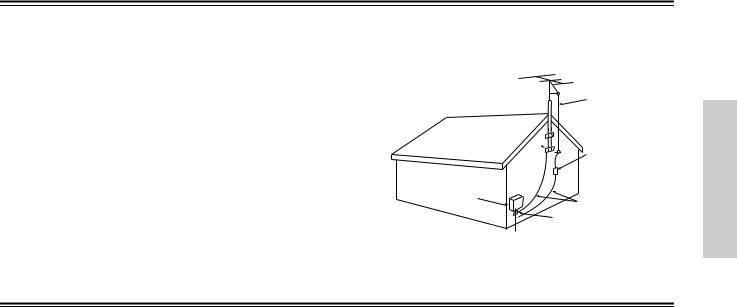
Important Safeguards—Continued
21.Replacement Parts—When replacement parts are required, be sure the service technician has used replacement parts specified by the manufacturer or have the same characteristics as the original part. Unauthorized substitutions may result in fire, electric shock, or other hazards.
22.Safety Check—Upon completion of any service or repairs to the appliance, ask the service technician to perform safety checks to determine that the appliance is in proper operation condition.
23.Wall or Ceiling Mounting—The appliance should be mounted to a wall or ceiling only as recommended by the manufacturer.
24.Heat—The appliance should be situated away from heat sources such as radiators, heat registers, stoves, or other appliances (including amplifiers) that produce heat.
25.Liquid Hazards—The appliance should not be exposed to dripping or splashing and no objects filled with liquids, such as vases should be placed on the appliance.
FIGURE 1:
EXAMPLE OF ANTENNA GROUNDING AS PER NATIONAL ELECTRICAL CODE, ANSI/NFPA 70
ANTENNA
LEAD IN
WIRE
GROUND  CLAMP
CLAMP 
ANTENNA DISCHARGE UNIT (NEC SECTION 810-20)
ELECTRIC
SERVICE
EQUIPMENT
GROUNDING CONDUCTORS (NEC SECTION 810-21)

 GROUND CLAMPS
GROUND CLAMPS

 POWER SERVICE GROUNDING NEC – NATIONAL ELECTRICAL CODE ELECTRODE SYSTEM
POWER SERVICE GROUNDING NEC – NATIONAL ELECTRICAL CODE ELECTRODE SYSTEM
(NEC ART 250, PART H)
S2898A
Precautions
For U.S. models
Note to CATV system installer:
This reminder is provided to call the CATV system installer's attention to Section 820-40 of the NEC which provides guidelines for proper grounding and, in particular, specifies that the cable ground shall be connected to the grounding system of the building, as close to the point of cable entry as practical.
For Canadian Models
NOTE: THIS CLASS B DIGITAL APPARATUS COMPLIES WITH CANADIAN ICES-003.
For models having a power cord with a polarized plug: CAUTION: TO PREVENT ELECTRIC SHOCK, MATCH WIDE BLADE OF PLUG TO WIDE SLOT, FULLY INSERT.
FCC Information for User
CAUTION:
The user changes or modifications not expressly approved by the party responsible for compliance could void the user’s authority to operate the equipment.
NOTE:
This equipment has been tested and found to comply with the limits for a Class B digital device, pursuant to Part 15 of the FCC Rules. These limits are designed to provide reasonable protection against harmful interference in a residential installation.
This equipment generates, uses and can radiate radio frequency energy and, if not installed and used in accordance with the instructions, may cause harmful interference to radio communications. However, there is no guarantee that interference will not occur in a particular installation. If this equipment does cause harmful interference to radio or television reception, which can be determined by turning the equipment off and on, the user is encouraged to try to correct the interference by one or more of the following measures:
•Reorient or relocate the receiving antenna.
•Increase the separation between the equipment and receiver.
•Connect the equipment into an outlet on a circuit different from that to which the receiver is connected.
•Consult the dealer or an experienced radio/TV technician for help.
Modèle canadien
REMARQUE: CET APPAREIL NUMÉRIQUE DE LA CLASSE B EST CONFORME À LA NORME NMB-003 DU CANADA.
Sur les modèles dont la fiche est polarisée:
ATTENTION: POUR ÉVITER LES CHOCS ÉLECTRIQUES, INTRODUIRE LA LAME LA PLUS LARGE DE LA FICHE DANS LA BORNE CORRESPONDANTE DE LA PRISE ET POUSSER JUSQU’AU FOND.
3
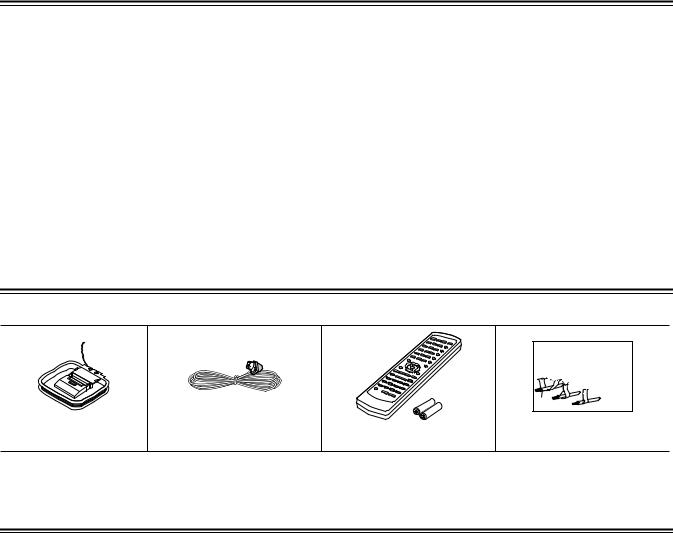
Precautions—Continued
1.Recording Copyright—Unless it’s for personal use only, recording copyrighted material is illegal without the permission of the copyright holder.
2.AC Fuse—The AC fuse inside the HT-R510 is not user-service- able. If you cannot turn on the HT-R510, contact your Onkyo dealer.
3.Care—Occasionally you should dust the HT-R510 all over with a soft cloth. For stubborn stains, use a soft cloth dampened with a weak solution of mild detergent and water. Dry the HT-R510 immediately afterwards with a clean cloth. Don’t use abrasive cloths, thinners, alcohol, or other chemical solvents, because they may damage the finish or remove the panel lettering.
4.Power
WARNING
BEFORE PLUGGING IN THE UNIT FOR THE FIRST TIME, READ THE FOLLOWING SECTION CAREFULLY.
AC outlet voltages vary from country to country. Make sure that the voltage in your area meets the voltage requirements printed on the HT-R510’s rear panel (AC 120 V, 60 Hz).
Setting the [STANDBY/ON] switch to STANDBY does not fully shutdown the HT-R510. If you do not intend to use the HT-R510 for an extended period, remove the power cord from the AC outlet.
Memory backup
The HT-R510 uses a battery-less memory backup system in order to retain radio presets and other settings when it’s unplugged or in the case of a power failure. Although no batteries are required, the HT-R510 must be plugged into an AC outlet in order to charge the backup system.
Once it has been charged, the HT-R510 will retain the settings for several weeks, although this depends on the environment and will be shorter in humid climates.
Supplied Accessories
Make sure you have the following accessories:
Front |
Left |
Front |
Left |
SP-B /Zone2 |
Left |
SP-B /Zone2 |
Left |
Front |
Right |
Front |
Right |
SP-B /Zone2 |
Right |
SP-B /Zone2 |
Right |
Surround |
Left |
Surround |
Left |
Surround |
Right |
Surround |
Right |
Center |
Center |
SurroundBack |
Left |
SurroundBack |
Left |
Zone2 |
Left |
Zone2 |
Left |
SurroundBack |
Right |
SurroundBack |
Right |
Zone2 |
Right |
Zone2 |
Right |
Front |
Left |
Front |
Left |
SP-B / Zone 2 |
Left |
SP-B / Zone 2 |
Left |
Front |
Right |
Front |
Right |
SP-B / Zone 2 |
Right |
SP-B / Zone 2 |
Right |
Surround |
Left |
Surround |
Left |
Surround |
Right |
Surround |
Right |
Center |
Center |
Surround Back |
Left |
Surround Back |
Left |
Zone 2 |
Left |
Zone 2 |
Left |
Surround Back |
Right |
Surround Back |
Right |
Zone 2 |
Right |
Zone 2 |
Right |
1
2
3
Speaker Cable
AM loop antenna |
Indoor FM antenna |
Remote controller & |
Speaker cable labels |
|
two batteries (AA/R6) |
||||
|
|
|
*In catalogs and on packaging, the letter added to the end of the product name indicates the color of the HT-R510. Specifications and operation are the same regardless of color.
Features
Amp |
FM/AM Tuner |
||
• |
6-channel amplifier |
• |
30 FM/AM presets |
• |
100 watts per channel min. RMS at 8 Ω, 2 channels driven |
• |
FM auto tuning |
from 20 Hz to 20 kHz with no more than 0.08% total harmonic distortion
•WRAT (Wide Range Amplifier Technology)
•Optimum gain volume circuitry
Audio/Video
•Dolby*1 Digital EX and Dolby Pro Logic II
•DTS, DTS-ES Matrix/Discrete 6.1, and DTS Neo:6 processing*2
•Cinema Filter function
•Advanced 24-bit DSP chip (5 DSP soundfields)
•Linear PCM 96 kHz/24-bit D/A converters on all channels
•Adjustable crossover (60, 80, 100, 120, 150 Hz)
•2 component video inputs, 1 output
•4 S-Video inputs, 2 outputs
•3 assignable digital inputs (2 optical, 1 coaxial)
•Subwoofer pre out
•Color-coded multi-channel inputs
•Color-coded speaker terminal posts (SPEAKERS B use push-type terminals)
*1. Manufactured under license from Dolby Laboratories. “Dolby,” “Pro Logic,” Surround EX,” and the double-D symbol are trademarks of Dolby Laboratories.
*2. “DTS,” “DTS-ES Extended Surround,” and “Neo:6” are trademarks of Digital Theater Systems, Inc.
4
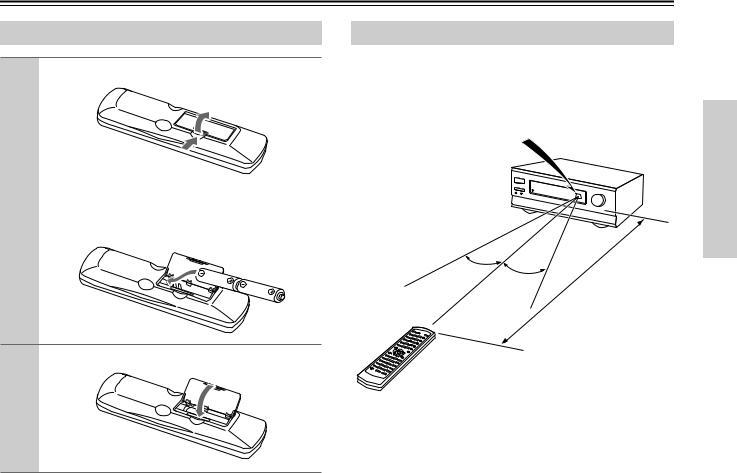
Before Using the HT-R510
Installing the Batteries
1 Open the battery compartment, as shown.
|
|
|
|
|
|
|
|
2 |
Insert the two supplied batteries (AA/R6) in |
||
|
accordance with the polarity diagram inside |
||
the battery compartment.
3 |
Close the battery compartment. |
Notes:
•The supplied batteries should last for about six months, although this will vary with usage.
•If the remote controller doesn’t work reliably, try replacing both batteries.
•Don’t mix new and old batteries, or different types of batteries.
•If you intend not to use the remote controller for a long time, remove the batteries to prevent possible leakage and corrosion.
•Flat batteries should be removed as soon as possible to prevent possible leakage and corrosion.
Using the Remote Controller
To use the remote controller, point it at the HT-R510’s remote control sensor, as shown below. The HT-R510’s STANDBY indicator flashes while a signal is being received from the remote controller.
Remote control sensor
HT-R510
Standby indicator 
30˚ |
|
|
|
|
m) |
30˚ |
|
|
|
(5 |
|
|
|
|
|
|
|
|
|
|
. |
|
|
|
|
16 |
ft |
|
|
|
|
|
|
|
|
|
. |
|
|
|
|
|
Approx |
|
|
|
|
Notes:
•The remote controller may not work reliably if the HT-R510 is subjected to bright light, such as direct sunlight or inverter-type fluorescent lights. Keep this in mind when installing the HT-R510.
•If another remote controller of the same type is used in the same room, or the HT-R510 is installed close to equipment that uses infrared rays, the remote controller may not work reliably.
•Don’t put anything, such as a book, on the remote controller, because the buttons may be pressed inadvertently, thereby draining the batteries.
•The remote controller may not work reliably if the HT-R510 is installed in a rack behind colored glass doors. Keep this in mind when installing the HT-R510.
•The remote controller will not work if there’s an obstacle between it and the HT-R510’s remote control sensor.
5
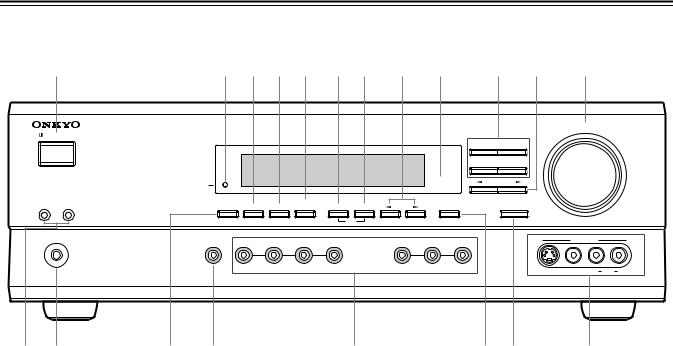
Controls & Connectors
Front Panel
1 |
2 3 4 5 6 7 8 9 J K L |
MASTER VOLUME
STANDBY/ON |
|
|
|
|
|
|
|
|
|
|
|
|
|
DIRECT |
STEREO |
|
|
|
|
|
|
SURROUND |
DSP |
|
STANDBY |
|
|
|
|
PRESET/ADJUST |
|
|
|
|
|
|
|
|
|
A SPEAKERS B |
|
SUBWOOFER |
|
|
|
|
|
DISPLAY |
DIMMER DIGITAL INPUT MODE |
MEMORY |
FM MODE |
TUNING |
SPEAKER ADJUST |
AUDIO ADJUST |
|
|
|
|
|
|
|
CLEAR |
|
|
|
|
|
|
|
PHONES |
|
AUDIO |
|
|
|
|
|
|
|
VIDEO 3 INPUT |
|
|
|
|
|
DVD |
VIDEO 1 |
VIDEO 2 |
VIDEO 3 |
TAPE |
TUNER |
C D |
|
|
|||
|
|
SELECTOR |
|
|
|
|
|||||||
|
|
|
|
VCR |
|
|
|
|
S VIDEO |
VIDEO |
L |
AUDIO |
R |
|
|
|
|
|
|
|
|
|
|||||
M N |
O |
P |
|
|
|
Q |
|
|
R S |
|
T |
|
|
For detailed information, refer to the pages in parenthesis.
ASTANDBY/ON button (24)
This button is used to set the HT-R510 to On or Standby. For models with a POWER switch, this button has no effect unless the POWER switch is set to ON.
BSTANDBY indicator (24)
This indicator lights up when the HT-R510 is in Standby mode, and it flashes while a signal is being received from the remote controller.
CDIMMER button (33)
This button is used to adjust the display brightness.
DDIGITAL INPUT button (24)
This button is used to assign the digital inputs.
ESUBWOOFER MODE button (25)
This button is used to select the Subwoofer modes.
FMEMORY button (30, 31)
This button is used when storing and deleting radio presets.
GFM MODE button (31)
This button is used to select the FM radio Stereo and Mono modes. It’s also used when deleting radio presets.
HTUNING [ ] [
] [ ] buttons (30)
] buttons (30)
These buttons are used to tune into radio stations.
IRemote control sensor (5)
This sensor receives control signals from the remote controller.
JListening mode buttons (36)
These buttons are used to select the listening modes.
KPRESET/ADJUST [ ] [
] [ ] buttons (25, 26, 31, 37)
] buttons (25, 26, 31, 37)
This button is used to select radio presets and adjust parameter values.
LMASTER VOLUME control (28, 30)
This control is used to set the volume of the HT-R510.
MSPEAKER A & B buttons (28, 32)
These buttons are used to turn speaker sets A and B on and off.
NPHONES jack (33)
This 1/4-inch phone jack is for connecting a standard pair of stereo headphones for private listening.
ODISPLAY button (32)
This button is used to display various information about the currently selected source.
PAUDIO SELECTOR button (28, 29)
This button is used to select the input signal format.
QInput selector buttons (24, 28–30, 39)
These buttons are used to select the audio and video sources: CD, DVD, TAPE, TUNER, VIDEO 1, VIDEO 2, or VIDEO 3.
RSPEAKER ADJUST button (25, 26)
This button is used to adjust various speaker-related parameters.
SAUDIO ADJUST button (37)
This button is used to set the Bass, Treble, Late Night, Cinema Filter, Center Image, Panorama, Dimension, and Center Width functions.
TVIDEO 3 INPUT connectors (15, 39)
These S-Video, composite video (RCA/phono), and analog audio (RCA/phono) inputs can be used to connect a video camera or games console.
6

Controls & Connectors—Continued
Display
|
1 |
2 |
|
|
|
|
|
3 |
|
|
|
|
|
4 |
|
|
||||||||
|
|
|
|
|
|
|
|
|
|
|
|
|
|
|
|
|
|
|
|
|
|
|
|
|
|
|
|
|
|
|
|
|
|
|
|
|
|
|
|
|
|
|
|
|
|
|
|
|
|
|
|
|
|
|
|
|
|
|
|
|
|
|
|
|
|
|
|
|
|
|
|
|
|
|
|
|
|
|
|
|
|
|
|
|
|
|
|
|
|
|
|
|
|
|
|
|
|
|
|
|
|
|
|
|
|
|
|
|
|
|
|
|
|
|
|
|
|
|
|
|
|
|
|
|
|
|
|
|
|
|
|
|
|
|
|
|
|
|
|
|
|
|
|
|
|
|
|
|
|
|
|
|
|
|
|
|
|
|
|
|
|
|
|
|
|
|
|
|
|
|
|
|
|
|
5 |
6 |
For detailed information, refer to the pages in parenthesis.
1A & B speaker indicators (28, 32)
Indicator A lights up when speaker set A is on. Indicator B lights up when speaker set B is on.
2MUTING indicator (32)
This indicator flashes when the HT-R510 is muted.
3Source/listening mode indicators (28, 36)
These indicators display information about the currently selected source and listening mode.
4Tuning indicators (30, 31)
TUNED (30): This indicator lights up when the HT-R510 is tuned into a radio station.
AUTO (30): This indicator lights up when the Auto Tuning function is on.
MEMORY (31): This indicator lights up when programming radio presets.
FM STEREO (31): This indicator lights up when the HT-R510 is tuned into a stereo FM station.
5SLEEP indicator (33)
This indicator lights up when the Sleep function has been set.
6Message area
This area of the display shows various information about the currently selected source.
7
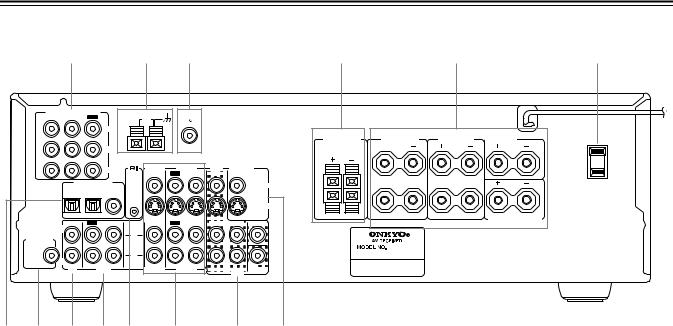
Controls & Connectors—Continued
Rear Panel
1 |
2 |
3 |
4 |
5 |
6 |
COMPONENT VIDEO |
ANTENNA |
FM |
|
VIDEO 1 / 2 / 3 DVD IN OUT |
AM |
||
IN |
75 |
||
|
|||
|
Y |
|
PB |
|
|
|
|
|
PR |
VIDEO 2 |
VIDEO 1 |
DVD |
MONITOR |
|
|
IN |
OUT |
IN |
IN |
OUT |
|
|
|
REMOTE |
|
|
|
|
DIGITAL INPUT |
CONTROL |
|
|
VIDEO |
|
|
OPTICAL |
COAXIAL |
|
|
|
|
|
2 |
1 |
|
|
|
|
|
|
|
|
|
|
S VIDEO |
IN |
OUT |
IN |
IN |
OUT |
IN |
FRONT SURR CENTER |
L |
|
|
|
|
|
L |
L
SUBWOOFER
PRE OUT
R |
|
R |
|
R |
|
|
|
||
CD |
TAPE |
VIDEO 2 |
VIDEO 1 |
SUB |
WOOFER |
||||
|
|
|
|
DVD |
|
|
|
|
AC OUTLET |
FRONT |
FRONT |
SURROUND |
CENTER |
AC 120V 60 Hz |
SPEAKERS B |
SPEAKERS A |
SPEAKERS |
SPEAKER |
SWITCHED |
|
L |
L |
|
120W 1 A MAX. |
|
|
|
||
L |
|
|
|
|
|
R |
R |
|
|
R |
|
|
|
|
|
|
|
SURROUND BACK |
|
|
|
|
SPEAKER |
|
|
HT-R510 |
|
|
|
7 8 9 J K L M N
For detailed information, refer to the pages in parenthesis.
ACOMPONENT VIDEO (10, 12, 14, 16)
These RCA/phono connectors can be used to connect a TV, DVD player, or other AV component with component video inputs and outputs.
BAM ANTENNA (22, 23)
These push terminals are for connecting an AM antenna.
CFM ANTENNA (22, 23)
This connector is for connecting an FM antenna.
DFRONT SPEAKERS B (21)
These push terminals are for connecting speaker set B.
EFRONT SPEAKERS A, SURROUND SPEAKERS, CENTER SPEAKER & SURROUND BACK SPEAKER (21)
These terminal posts are for connecting speaker set A, including the front, surround, center, and surround-back speakers. They accept bare wires or banana plugs.
FAC OUTLET (11)
This switched AC outlet can be used to supply power to another AV component.
GDIGITAL INPUT OPTICAL 1, 2 & COAXIAL (10, 13, 14, 16–18)
These optical and coaxial connectors can be used to connect a CD, DVD, or LD (laser disc) player, or other AV component with digital outputs.
HSUBWOOFER PRE OUT (21)
K 
 (19)
(19)
This  (Remote Interactive) connector can be connected to the
(Remote Interactive) connector can be connected to the  connector on another Onkyo AV component, for example, a CD player, DVD player, or cassette recorder. The HT-R510’s remote controller can then be used to control that component. To use
connector on another Onkyo AV component, for example, a CD player, DVD player, or cassette recorder. The HT-R510’s remote controller can then be used to control that component. To use  , you must make an analog RCA/ phono connection between your HT-R510 and the other AV component, even if they are connected digitally.
, you must make an analog RCA/ phono connection between your HT-R510 and the other AV component, even if they are connected digitally.
LVIDEO 1 IN/OUT & VIDEO 2 IN (10, 14–16, 39)
These connectors can be used to connect a VCR or other AV component. There are RCA/phono connectors for connecting to stereo analog audio inputs and outputs, and S-Video and composite video (RCA/phono) connectors for connecting to video inputs and outputs.
MDVD IN/MULTI CH INPUT (10, 12, 13)
The FRONT, SURR, CENTER, and SUBWOOFER RCA/ phono connectors can be used to connect AV components with multiple analog audio outputs, including DVD players with individual 5.1 surround analog outputs. There’s an S-Video input and composite video (RCA/phono) input for connecting the video signal.
NMONITOR OUT (10, 12)
These S-Video and composite video (RCA/phono) outputs can be connected to the video input on your TV or projector.
This RCA/phono connector can be used to connect an active subwoofer.
ICD IN (10, 17)
These RCA/phono connectors can be used to connect a CD player with analog outputs.
JTAPE IN/OUT (10, 17, 18)
These RCA/phono connectors can be used to connect a cassette recorder, MiniDisc recorder, or other recorder with analog inputs and outputs.
Tip:
A turntable with a built-in preamp can be connected to a pair of unused HT-R510 analog inputs. To connect a turntable without a built-in preamp, you’ll need a commercially available phono preamp. See pages 17 and 18 and the instructions supplied with your phono preamp and turntable for more information.
8
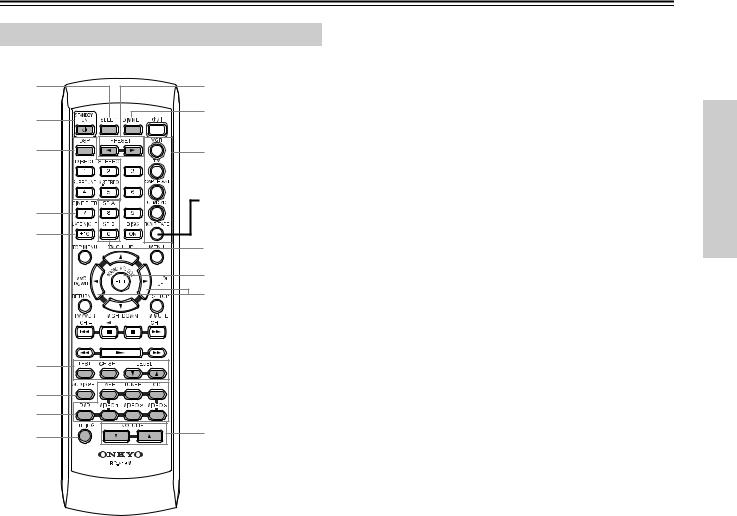
Controls & Connectors—Continued
Remote Controller—RCVR Mode
RC-518M |
|
1 |
J |
2 |
K |
|
|
3 |
L |
4 |
Press this to select |
RCVR mode |
|
5 |
|
|
M |
|
N |
|
O |
6 |
|
7 |
|
8 |
|
9 |
P |
This page describes only those buttons that can be used to control the HT-R510 when the remote controller is in RCVR mode (Receiver mode). The other modes, and information on using the remote controller to control your other AV components, are explained on page 41.
To select RCVR mode, press the [RCVR] button.
For detailed information, refer to the pages in parenthesis.
ASLEEP button (33)
This button is used to set the Sleep function. This function can be set only with the remote controller.
BSTANDBY/ON button (24)
This button is used to set the HT-R510 to On or Standby.
CListening mode buttons (36)
These buttons are used to select the listening modes.
DCINE FLTR button (37)
This button is used to set the Cinema Filter function.
ELATE NIGHT button (37)
This button is used to set the Late Night function.
FTEST, CH SEL & LEVEL [ ] [
] [ ] buttons (27, 29, 33)
] buttons (27, 29, 33)
These buttons are used to set the level of each speaker individually. This function can be set only with the remote controller.
GAUDIO SEL button (29)
This button is used to select analog or digital inputs for the CD, DVD, TAPE, VIDEO 1, VIDEO 2, and VIDEO 3 sources.
HInput selector buttons (28, 30, 39)
These buttons are used to select the audio and video sources: CD, DVD, TAPE, TUNER, VIDEO 1, VIDEO 2, and VIDEO 3.
IMUTING button (32)
This button is used to mute the HT-R510. This function can be set only with the remote controller.
JPRESET [ ] [
] [ ] buttons (31)
] buttons (31)
These buttons are used to select radio presets.
KDIMMER button (33)
This button is used to adjust the display brightness.
LRemote Controller Mode buttons (28, 41)
These buttons are used to select the remote controller modes. To select RCVR mode, press the [RCVR] button.
MSP A & SP B buttons (28, 32)
These buttons are used to turn on and off speaker sets A and B individually.
NAUDIO ADJUST button (37)
This button is used to set the Bass, Treble, Late Night, Cinema Filter, Center Image, Panorama, Dimension, and Center Width functions.
OADJUST [ ] [
] [ ] buttons (37)
] buttons (37)
These buttons are used to adjust the functions selected with the AUDIO ADJUST button.
PVOLUME [ ] [
] [ ] buttons (27, 28, 33)
] buttons (27, 28, 33)
These buttons are used to set the volume of the HT-R510.
9
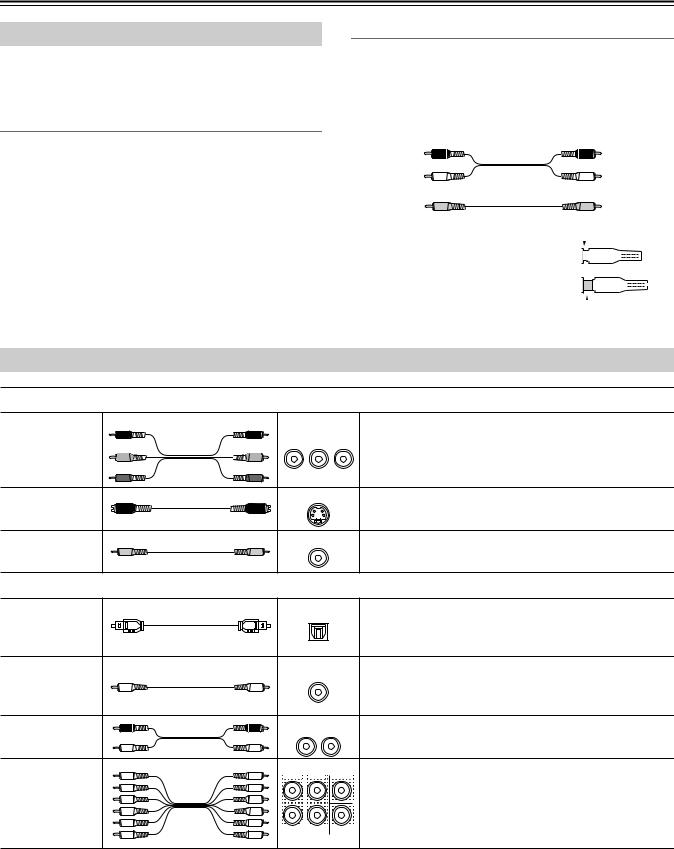
Connecting Your AV Components
Before Making Any Connections
•Read the manuals supplied with your AV components.
•Don’t connect the power cord until you’ve completed all audio and video connections.
Optical Digital Inputs
The HT-R510’s optical digital connectors have a shutter-type cover that opens when an optical plug is inserted, and closes when it’s removed. Push the plug in all the way.
RCA/phono AV Connection Color Coding
RCA/phono AV connections are usually color coded: red, white, and yellow. Use red plugs to connect right-channel audio inputs and outputs (typically labeled “R”). Use white plugs to connect left-channel audio inputs and outputs (typically labeled “L”). And use yellow plugs to connect composite video inputs and outputs.
Right (red) |
Analog audio |
Right (red) |
Left (white) |
|
Left (white) |
(Yellow) |
Composite video |
(Yellow) |
|
• Push the plugs in all the way to make |
|
|
|
|
Right! |
|
|
|
|
|
|
|
|
||||||||
a good connection. |
|
|
|
|
|
|
|
|
|
|
|
|
|
|
|
|
|
|
|
|
|
|
|
|
|
|
|
|
|
|
|
|
|
|
|
|
|
|
|
|
|
|
|
• To prevent interference, keep audio |
|
|
|
|
|
|
|
|
|
|
|
|
|
|
|
|
|
|
|
|
|
and video cables away from power |
|
|
|
|
|
|
|
|
|
|
|
|
|
|
|
|
|
|
|
|
|
cords and speaker cables. |
|
|
|
|
|
Wrong! |
|
|
|
|
|
|
|
|
|||||||
|
|
|
|
|
|
|
|
|
|
|
|
|
|||||||||
|
|
|
|
|
|
|
|
|
|
|
|
|
|||||||||
|
|
|
|
|
|
|
|
|
|
|
|
|
|
||||||||
AV Cables & Connectors
|
|
|
Video |
|
|
PR / CR |
PR / CR |
|
Component video separates the luminance (Y) and color |
Component |
PB /CB |
Y |
PB PR difference signals (PR, PB), providing the best picture |
|
video |
PB / CB |
|
quality. Some TV manufacturers label their component |
|
Y |
Y |
|
||
|
|
video inputs differently. |
||
|
|
|
|
|
|
|
|
S VIDEO |
S-Video provides better picture quality than composite |
S-Video |
|
|
|
|
|
|
|
video. |
|
|
|
|
|
|
Composite |
|
|
VIDEO |
Composite video can be found on virtually all TVs, |
video |
|
|
|
VCRs, and video equipment. |
|
|
|
Audio |
|
Optical digital
Coaxial digital
Analog
Multi-channel connection
OPTICAL |
Optical digital audio connections provide better audio |
|
quality than analog connections. Audio quality is the |
|
same as for coaxial. |
Coaxial digital audio connections provide better audio
COAXIAL
quality than analog connections. Audio quality is the same as for optical.
|
AUDIO |
RCA/phono analog audio connectors can be found on |
L |
R |
|
|
|
virtually all AV components. |
FRONT |
SURR CENTER |
To connect an AV component with multiple analog audio |
L |
|
outputs, for example, a DVD player with individual 5.1 |
|
|
|
|
|
surround analog outputs, you need to make six connec- |
R |
SUB |
tions, which can be done with three stereo RCA/phono |
|
audio cables. |
|
|
WOOFER |
10
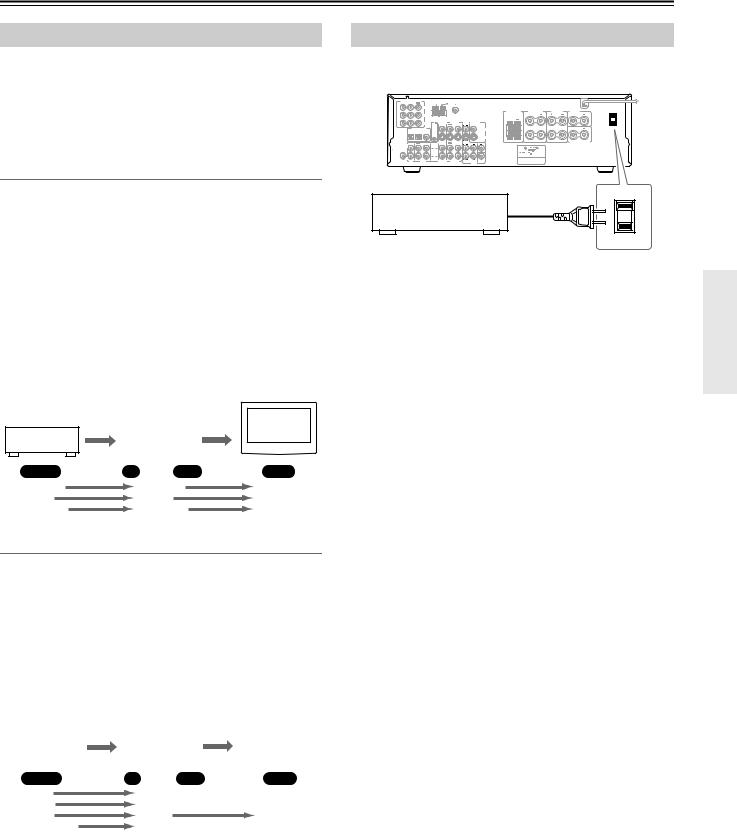
Connecting Your AV Components—Continued
Which Connections To Use?
The HT-R510 offers several connection formats for compatibility with a wide range of AV equipment. The format you choose will depend on the formats supported by your AV components. Use the following sections as a guide.
Using the AC OUTLET
The switched AC outlet on the HT-R510’s rear panel can be used to supply power to another AV component, as shown.
COMPONENT VIDEO |
ANTENNA |
FM |
|
|
|
|
VIDEO 1 / 2 / 3 DVD IN OUT |
AM |
|
|
|
|
|
IN |
75 |
|
|
|
AC OUTLET |
|
Y |
|
|
|
|
|
|
|
|
FRONT |
FRONT |
SURROUND |
CENTER |
AC 120V 60 Hz |
|
|
SWITCHED |
||||
|
|
SPEAKERS B |
SPEAKERS A |
SPEAKERS |
SPEAKER |
120W 1 A MAX. |
PB |
|
|
L |
L |
|
|
When connecting video equipment, you need to make video and audio connections.
Video Connection Formats
|
PR |
VIDEO 2 |
VIDEO 1 |
DVD |
MONITOR |
|
|
|
|
|
IN |
OUT |
IN |
IN |
OUT |
L |
|
DIGITAL INPUT |
REMOTE |
|
|
|
|
|
||
CONTROL |
|
|
|
VIDEO |
R |
R |
||
OPTICAL |
COAXIAL |
|
|
|
|
|||
2 |
1 |
|
|
|
|
|
|
|
|
|
|
|
|
|
|
R |
|
|
|
|
|
|
|
|
|
S VIDEO |
|
IN |
OUT |
IN |
IN |
OUT |
IN |
FRONT |
SURR |
CENTER |
SURROUND BACK |
SPEAKER |
|||||||||
L |
|
|
L |
|
|
|
L |
|
|
SUBWOOFER |
|
|
|
|
|
|
|
|
|
PRE OUT |
|
|
|
|
|
|
|
|
HT-R510 |
R |
|
|
R |
|
|
|
R |
|
|
|
|
|
|
|
|
|
|
CD |
TAPE |
VIDEO 2 |
VIDEO 1 |
SUB |
WOOFER |
||||
|
|
|
|
DVD |
Video equipment can be connected to the HT-R510 using the following video connection formats: composite video, S-Video, or component video, the latter offering the best picture quality.
When choosing a connection format, bear in mind that the HT-R510 doesn’t convert between formats, so only output connectors of the same format as the input connector will output a signal, as shown below.
For example, if you connect your DVD player to the S-VIDEO DVD IN, a video signal will be output by the S-VIDEO MONITOR OUT (for your TV) and the S-VIDEO VIDEO 1 OUT (for your VCR), but not the composite video or component video outputs.
AV component
Make sure that the wattage requirements of the AV component that you connect to the HT-R510’s AC outlet do not exceed the maximum wattage printed on the rear panel.
|
|
|
|
|
|
|
|
|
|
|
|
|
|
TV, |
|
||
DVD player, |
|
|
|
|
|
|
|
|
|
|
|
|
projector, |
|
|||
|
|
|
|
HT-R510 |
|
|
|
|
etc. |
|
|||||||
etc. |
|
|
|
|
|
|
|
|
|
|
|
||||||
|
|
|
|
|
|
|
|
|
|
|
|
|
|
|
|
|
|
Output |
|
IN |
OUT |
|
|
Input |
|
||||||||||
Composite |
|
|
|
|
Composite |
|
Composite |
|
|||||||||
S-Video |
|
|
|
|
S-Video |
|
S-Video |
|
|||||||||
Component |
|
|
|
|
Component |
|
Component |
|
|||||||||
Audio Connection Formats
Audio equipment can be connected to the HT-R510 using the following audio connection formats: analog, optical, coaxial, and multi-channel (5.1).
When choosing a connection format, bear in mind that the HT-R510 doesn’t convert between formats, as shown below.
For example, audio signals connected to the OPTICAL or COAXIAL digital input are not output by the analog TAPE OUT connectors, so if you want to record from, for example, your CD player, in addition to connecting it to a digital input, you must also connect it to the analog CD IN connectors.
|
|
DVD player, |
|
|
|
|
|
HT-R510 |
|
|
|
|
MD recorder, |
|||||||||||||||||
|
|
|
|
etc. |
|
|
|
|
|
|
|
|
|
|
|
etc. |
||||||||||||||
|
|
|
|
|
|
|
|
|
|
|
|
|
|
|
|
|
|
|
|
|
||||||||||
|
|
|
|
Output |
|
|
IN |
OUT |
|
|
|
|
|
Input |
||||||||||||||||
|
|
|
Optical |
|
|
|
|
|
Optical |
Not output |
||||||||||||||||||||
|
|
|
Coaxial |
|
|
|
|
|
Coaxial |
Not output |
||||||||||||||||||||
|
|
|
Analog |
|
|
|
|
|
Analog |
|
|
|
|
|
|
|
|
|
|
|
Analog |
|||||||||
|
|
|
Multi-channel |
|
|
|
|
|
Multi-channel |
Not output |
||||||||||||||||||||
11
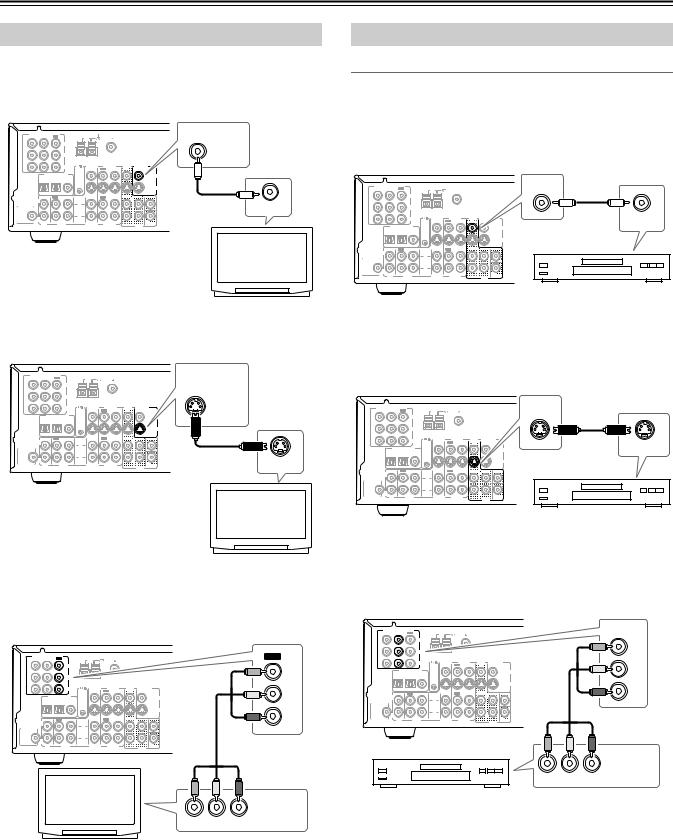
Connecting Your AV Components—Continued
Connecting Your TV or Projector
■ Using Composite Video
Use a composite video cable to connect the HT-R510’s VIDEO MONITOR OUT to a composite video input on your TV, as shown.
COMPONENT VIDEO |
ANTENNA |
|
MONITOR |
VIDEO 1 / 2 / 3 DVD IN OUT |
AM |
FM |
OUT |
IN |
|
75 |
|
|
Y |
|
|
|
PB |
|
VIDEO |
Connecting a DVD player
Video Connections
■ Using Composite Video
Use a composite video cable to connect the HT-R510’s VIDEO DVD IN to the composite video output on your DVD player, as shown.
• Your TV must also be connected via composite video.
|
|
PR |
VIDEO 2 |
VIDEO 1 |
DVD |
MONITOR |
|
|
|
|
|
|
|
|
|
||
|
|
|
IN |
OUT |
IN |
IN |
OUT |
|
|
|
|
|
|
|
|
|
|
|
|
|
REMOTE |
|
|
|
|
|
|
|
|
|
|
|
|
|
|
|
DIGITAL INPUT |
CONTROL |
|
|
|
|
VIDEO |
|
|
|
|
|
|
|
|
|
|
OPTICAL |
COAXIAL |
|
|
|
|
|
|
|
|
|
|
|
|
|
|
||
|
2 |
1 |
|
|
|
|
|
|
|
|
|
|
|
|
|
|
DVD |
|
|
|
|
|
|
|
|
|
COMPONENT VIDEO |
|
ANTENNA |
|
|
|
|||
|
|
|
|
|
|
|
|
S VIDEO |
VIDEO 1 / 2 / 3 |
DVD IN |
OUT |
|
AM |
|
FM |
|
IN |
|
|
|
|
|
|
|
|
|
IN |
|
|
|
|
75 |
|
||
IN |
OUT |
IN |
IN |
OUT |
IN |
FRONT |
SURR |
CENTER |
|
|
|
Y |
|
|
|
|
|
L |
|
|
L |
|
|
L |
|
|
|
|
|
|
|
|
|
|
|
PRE OUT |
|
|
|
|
|
|
|
VIDEO IN |
|
|
|
|
|
|
|
|
|
SUBWOOFER |
|
|
|
|
|
|
|
|
|
|
|
PB |
|
|
|
|
|
R |
|
|
R |
|
|
R |
|
SUB |
|
|
|
PR |
IN |
OUT |
IN |
IN |
VIDEO OUT |
|
|
|
|
|
|
|
|
|
|
|
|
|
VIDEO 2 |
VIDEO 1 |
DVD |
|
|
CD |
|
TAPE |
VIDEO 2 |
VIDEO 1 |
|
DVD |
WOOFER |
|
DIGITAL INPUT |
REMOTE |
|
|
|
|
|||
|
|
|
|
|
|
|
|
|
CONTROL |
|
|
|
|
||||
|
|
|
|
|
|
|
|
|
|
OPTICAL |
COAXIAL |
|
|
|
|
||
|
|
|
|
|
|
|
|
|
|
|
2 |
1 |
|
|
|
|
|
S VIDEO
DVD player
IN |
OUT |
IN |
IN |
OUT |
IN |
FRONT SURR CENTER |
TV, projector, etc. |
L |
|
L |
|
L |
PRE OUT |
|
|
|
||
|
SUBWOOFER |
|
|
|
|
|
R |
|
R |
|
R |
|
|
|
|
||
|
CD |
TAPE |
VIDEO 2 |
VIDEO 1 |
SUB |
|
WOOFER |
||||
|
|
|
|
|
DVD |
■ Using S-Video
Use an S-Video cable to connect the HT-R510’s S VIDEO MONITOR OUT to an S-Video input on your TV, as shown.
■ Using S-Video
Use an S-Video cable to connect the HT-R510’s S VIDEO DVD IN to the S-Video output on your DVD player, as shown.
COMPONENT VIDEO |
ANTENNA |
FM |
VIDEO 1 / 2 / 3 DVD IN OUT |
AM |
|
IN |
|
75 |
Y
PB
MONITOR OUT
• Your TV must also be connected via S-Video.
|
|
PR |
VIDEO 2 |
VIDEO 1 |
DVD |
|
S VIDEO |
COMPONENT VIDEO |
ANTENNA |
|
FM |
|
|||
|
|
|
IN |
OUT |
IN |
IN |
|
|
VIDEO 1 / 2 / 3 |
DVD IN |
OUT |
AM |
|
|
|
|
DIGITAL INPUT |
REMOTE |
|
|
|
|
|
IN |
|
|
|
|
75 |
|
|
|
CONTROL |
|
|
|
|
|
|
|
Y |
|
|
|
|
||
|
OPTICAL |
COAXIAL |
|
|
|
|
|
|
|
|
|
|
|
|
|
|
2 |
1 |
|
|
|
|
|
|
|
|
|
|
|
|
|
|
|
|
|
|
|
|
|
|
|
|
PB |
|
|
|
|
IN |
OUT |
IN |
IN |
OUT |
IN |
FRONT |
SURR |
CENTER |
|
|
PR |
VIDEO 2 |
VIDEO 1 |
DVD |
|
L |
|
|
|
|
|
|
L |
|
|
|
|
IN |
OUT |
IN |
IN |
L |
DIGITAL INPUT |
REMOTE |
|
SUBWOOFER |
CONTROL |
||
PRE OUT |
OPTICAL |
COAXIAL |
|
|
|
|
|
|
2 |
1 |
R |
|
R |
R |
|
|
|
|
|
SUB |
S VIDEO IN |
|
||
CD |
TAPE |
|
DVD |
|
||
VIDEO 2 |
VIDEO 1 |
WOOFER |
|
|
IN |
OUT |
IN |
IN |
OUT |
IN |
FRONT |
SURR |
CENTER |
L |
|
|
L |
|
|
|
L |
|
SUBWOOFER |
|
|
|
|
|
|
|
|
|
|
|
|
|
|
|
|
|
PRE OUT |
|
|
|
|
|
|
|
|
R |
|
|
R |
|
|
|
R |
|
|
|
|
|
|
|
SUB |
||
CD |
|
TAPE |
VIDEO 2 |
VIDEO 1 |
|
DVD |
WOOFER |
|
|
|
|
|
|
|
|
|
|
DVD
IN
S VIDEO OUT
DVD player
TV, projector, etc.
■ Using Component Video
Use a component video cable to connect the HT-R510’s COMPONENT VIDEO OUT connectors to the component video inputs on your TV, as shown.
VIDEO 1 / 2 / 3 DVD IN |
OUT |
OUT |
COMPONENT VIDEO |
|
|
IN
Y
■ Using Component Video
Use a component video cable to connect the HT-R510’s COMPONENT DVD IN connectors to the component video outputs on your DVD player, as shown.
• Your TV must also be connected via component video.
COMPONENT VIDEO |
DVD IN |
||
IN |
/ 2 / 3 DVD IN |
OUT |
|
VIDEO 1 |
|
||
|
|
|
Y |
|
DIGITAL INPUT |
PB |
|
|
OPTICAL |
|
|
|
2 |
1 |
|
DIGITAL INPUT |
PB |
IN |
OUT |
|
|
PR |
|
L |
|
|
|
|
|||
OPTICAL |
|
|
|
|
|
||
2 |
1 |
|
SUBWOOFER |
|
|
|
|
|
|
|
PRE OUT |
|
|
|
|
IN |
OUT |
PR |
R |
TAPE |
VIDEO 2 |
R |
SUB |
|
CD |
VIDEO 1 |
WOOFER |
||||
L |
|
|
|
|
|
|
DVD |
SUBWOOFER
PRE OUT
R |
|
|
|
|
SUB |
CD |
TAPE |
VIDEO 2 |
VIDEO 1 |
|
|
|
WOOFER |
||||
|
|
|
|
DVD |
DVD player |
COMPONENT
VIDEO OUT
Y PB PR
TV, projector, etc. |
COMPONENT |
|
VIDEO IN |
Y PB |
PR |
12
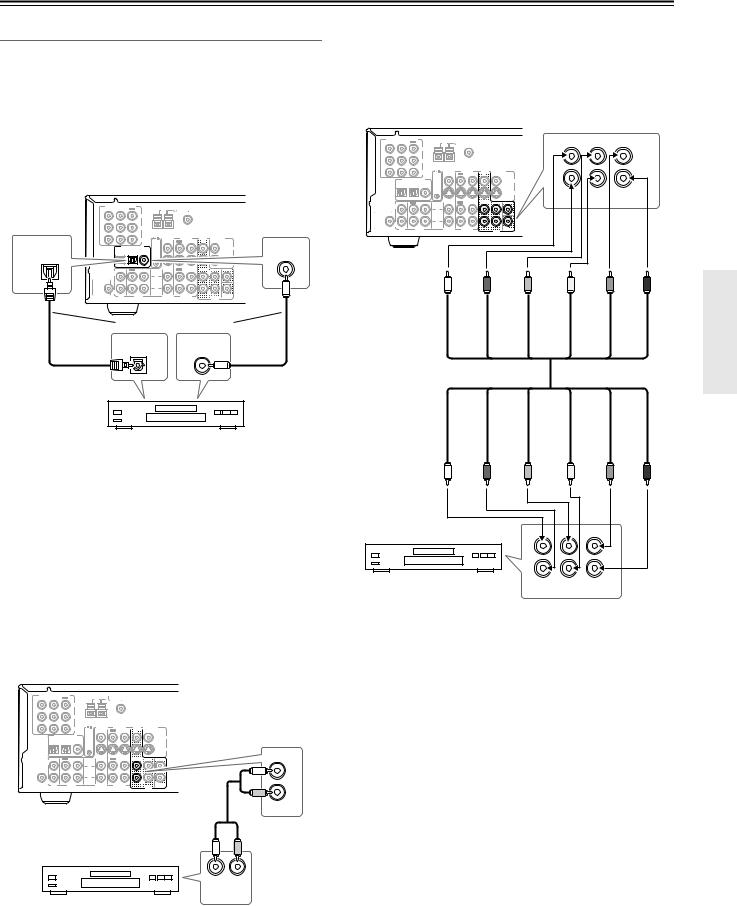
Connecting Your AV Components—Continued
Audio Connections
■ Using Coaxial or Optical Connections
•Use a coaxial digital audio cable to connect the HT-R510’s COAXIAL DIGITAL INPUT to the coaxial output on your DVD player, as shown.
OR
•Use an optical digital audio cable to connect the HT-R510’s OPTICAL 1 DIGITAL INPUT to the optical output on your DVD player, as shown.
COMPONENT VIDEO |
ANTENNA |
FM |
|
VIDEO 1 / 2 / 3 DVD IN |
OUT |
AM |
|
IN |
|
|
75 |
|
Y |
|
|
|
PB |
|
|
|
PR |
|
COAXIAL |
OPTICAL |
INPUT |
|
|
COAXIAL |
|
||
1 |
1 |
|
|
|
|
|
|
IN
TAPE |
VIDEO 2 |
VIDEO 1 |
WOOFER |
|
|
|
DVD |
Connect one or the other
DIGITAL OUT |
DIGITAL OUT |
OPTICAL |
COAXIAL |
■ Using Multi-channel Connections
Use a multi-channel RCA/phono audio cable to connect the HT-R510’s L/R FRONT, L/R SURR, CENTER, and SUB WOOFER DVD IN connectors to the 5.1 analog outputs on your DVD player, as shown.
Alternatively, use three stereo RCA/phono audio cables.
COMPONENT VIDEO |
|
ANTENNA |
|
75 |
|
FRONT |
SURR |
CENTER |
||
IN |
/ 2 / 3 |
DVD IN OUT |
|
AM |
|
|
||||
VIDEO 1 |
|
|
|
FM |
|
|
L |
|
||
|
|
|
Y |
|
|
|
|
|
|
|
|
|
|
PB |
|
|
|
|
|
|
|
|
|
|
PR |
VIDEO 2 |
VIDEO 1 |
DVD |
MONITOR |
|
|
|
|
|
|
|
IN |
OUT |
IN |
IN |
OUT |
|
|
|
|
|
|
REMOTE |
|
|
|
|
|
|
|
|
DIGITAL INPUT |
CONTROL |
|
|
|
VIDEO |
|
|
|
|
|
OPTICAL |
COAXIAL |
|
|
|
|
|
||
2 |
1 |
R |
|
|
|
|
|
|
|
|
S VIDEO |
|
SUB |
IN |
OUT |
IN |
IN |
OUT |
IN |
FRONT |
SURR |
CENTER |
DVD |
WOOFER |
L |
|
|
L |
|
|
|
L |
|
|
|
SUBWOOFER |
|
|
|
|
|
|
|
|
|
|
PRE OUT |
|
|
|
|
|
|
|
|
|
|
R |
|
|
R |
|
|
|
R |
|
|
|
|
|
|
|
|
|
SUB |
|
|
||
CD |
|
TAPE |
VIDEO 2 |
VIDEO 1 |
|
DVD |
WOOFER |
|
|
|
|
|
|
|
|
|
|
|
|
|
|
FRONT L |
FRONT R |
SURR L |
SURR R |
CENTER |
SUBWOOFER |
DVD player
Initially, the COAXIAL digital input is assigned to the DVD input source. If you connect your DVD player to a different digital input, you’ll need to assign that input to the DVD input source (see page 24).
FRONT L |
FRONT R |
SURR L |
SURR R |
CENTER |
SUBWOOFER |
■ Using Analog Connections |
DVD player |
Even if your DVD player is connected digitally (coaxial or optical), to use 
 , or to record audio from your DVD player, you’ll need to make analog connections as well.
, or to record audio from your DVD player, you’ll need to make analog connections as well.
Use an RCA/phono audio cable to connect the HT-R510’s FRONT DVD IN connectors to the analog audio outputs on your DVD player, as shown.
If your DVD player has L/R outputs and multi-channel 5.1 outputs, be sure to use the L/R outputs.
CENTER
L L
R R
FRONT SURR SUB WOOFER
COMPONENT VIDEO |
ANTENNA |
FM |
VIDEO 1 / 2 / 3 DVD IN OUT |
AM |
|
IN |
|
75 |
Y
|
|
PB |
|
|
|
|
|
|
|
|
|
PR |
VIDEO 2 |
VIDEO 1 |
DVD |
MONITOR |
|
||
|
|
|
IN |
OUT |
IN |
IN |
OUT |
|
|
|
|
|
REMOTE |
|
|
|
|
|
|
|
DIGITAL INPUT |
CONTROL |
|
|
|
|
VIDEO |
|
|
|
OPTICAL |
COAXIAL |
|
|
|
|
|
|
|
|
2 |
1 |
|
|
|
|
|
|
|
|
|
|
|
|
|
|
|
S VIDEO |
|
IN |
OUT |
IN |
IN |
OUT |
IN |
FRONT |
SURR |
CENTER |
FRONT |
L |
|
|
L |
|
|
|
L |
|
|
SUBWOOFER |
|
|
|
|
|
|
|
L |
|
|
|
|
|
|
|
|
|
||
PRE OUT |
|
|
|
|
|
|
|
|
|
R |
|
|
R |
|
|
|
R |
|
|
|
|
|
|
|
|
SUB |
|
||
CD |
TAPE |
VIDEO 2 |
VIDEO 1 |
|
DVD |
WOOFER |
|
||
|
|
|
|
|
|
|
|
R |
|
|
|
|
|
|
|
|
|
|
|
|
|
|
|
|
|
|
|
|
DVD |
DVD player
L R
AUDIO
OUTPUT
13
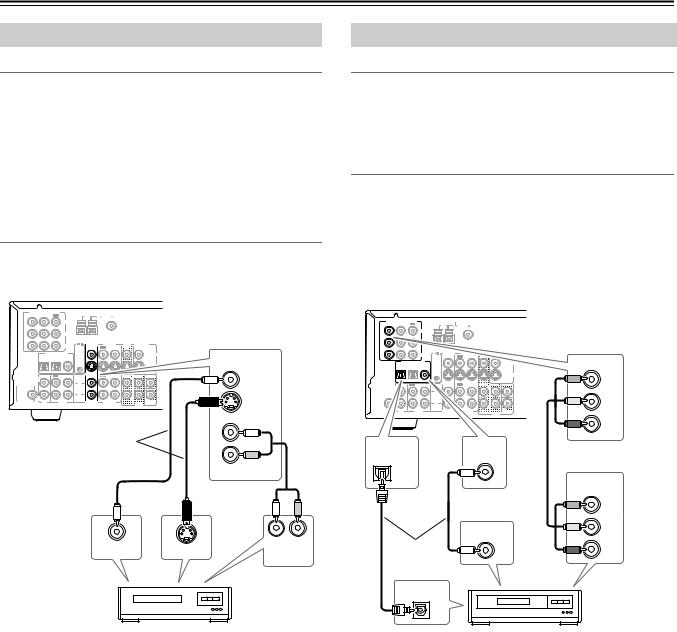
Connecting Your AV Components—Continued
Connecting a VCR for Playback
Video Connections
•Use an S-Video cable to connect the HT-R510’s S VIDEO VIDEO 2 IN to the S-Video output on your VCR, as shown. Your TV must also be connected via S-Video.
OR
•Use a composite video cable to connect the HT-R510’s VIDEO VIDEO 2 IN to a composite video output on your VCR, as shown. Your TV must also be connected via composite video.
Audio Connections
Connecting a D-VHS Recorder
Video connections
Use a component video cable to connect the HT-R510’s COMPONENT VIDEO 1/2/3 IN connectors to the component video outputs on your D-VHS recorder, as shown.
• Your TV must also be connected via component video.
Audio connections
•Use a coaxial digital audio cable to connect the HT-R510’s COAXIAL DIGITAL INPUT to the coaxial output on your D-VHS recorder, as shown.
OR
Use an RCA/phono audio cable to connect the HT-R510’s L/ R VIDEO 2 IN connectors to the analog audio outputs on your VCR, as shown.
•Use an optical digital audio cable to connect the HT-R510’s OPTICAL 2 DIGITAL INPUT to the optical output on your D-VHS recorder, as shown.
COMPONENT VIDEO |
ANTENNA |
FM |
|
|
|
VIDEO 1 / 2 / 3 DVD IN OUT |
AM |
|
|
|
|
IN |
|
75 |
|
|
|
Y |
|
COMPONENT VIDEO |
ANTENNA |
FM |
|
|
|
VIDEO 1 / 2 / 3 |
OUT |
AM |
|
|
|
IN |
|
|
75 |
PB |
|
|
|
|
|
|
PR |
VIDEO 2 |
|
|
IN |
|
|
REMOTE |
DIGITAL INPUT |
CONTROL |
|
OPTICAL |
COAXIAL |
VIDEO 2 |
2 |
1 |
|
|
|
IN |
IN OUT IN |
IN |
VIDEO |
L |
|
L
SUBWOOFER
PRE OUT
R |
|
R |
|
|
|
S VIDEO |
|
CD |
TAPE |
VIDEO |
VIDEO 1 / 2 / 3 IN
Y
PB
Connect one or the other
IN
PR
COAXIAL
2
VIDEO 2
COMPONENT
VIDEO OUT
|
|
|
|
|
Y |
|
|
|
|
|
DIGITAL OUT |
PB |
|
|
|
L |
R |
COAXIAL |
|
|
VIDEO OUT |
|
Connect one |
|
|||
S VIDEO OUT |
AUDIO |
PR |
||||
or the other |
||||||
|
|
OUTPUT |
|
|||
VCR |
|
|
|
DIGITAL OUT |
|
|
|
|
|
OPTICAL |
D-VHS recorder |
||
|
|
|
|
|
||
You may need to change the input source to digital input assignments (see page 24).
14
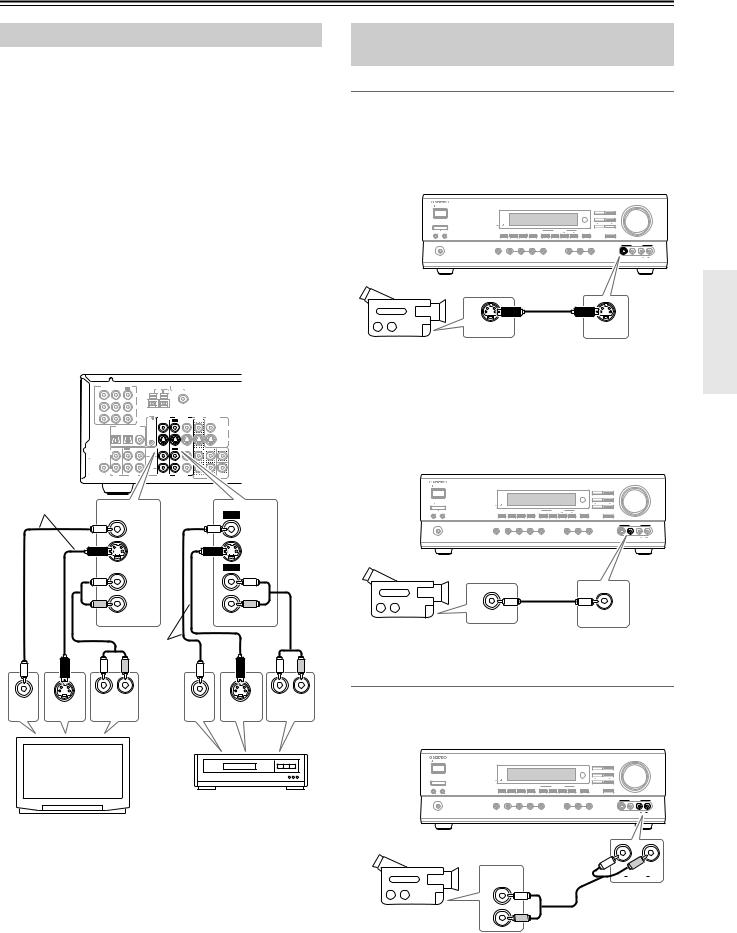
Connecting Your AV Components—Continued
Connecting a VCR for Recording
If your TV has AV outputs and you want to record from your TV to your VCR via the HT-R510, make the following connections.
Connecting a Camcorder, Games Console, etc.
Video Connections
•Use an S-Video cable to connect the HT-R510’s S VIDEO VIDEO 2 IN to an S-Video output on your TV, and use another S-Video cable to connect the HT-R510’s S VIDEO VIDEO 1 OUT to an S-Video input on your VCR, as shown.
OR
•Use a composite video cable to connect the HT-R510’s VIDEO VIDEO 2 IN to a composite video output on your TV, and use another composite video cable to connect the HT-R510’s VIDEO VIDEO 1 OUT to a composite video input on your VCR, as shown.
Use an RCA/phono audio cable to connect the HT-R510’s L/ R VIDEO 2 IN connectors to the analog audio outputs on your TV, and use another RCA/phono audio cable to connect the HT-R510’s L/R VIDEO 1 OUT connectors to the analog audio inputs on your VCR, as shown.
Connect one or the other
COMPONENT VIDEO |
ANTENNA |
FM |
VIDEO 1 / 2 / 3 DVD IN OUT |
AM |
|
IN |
|
75 |
Y
PB |
|
|
|
|
|
PR |
VIDEO 2 |
VIDEO 1 |
DVD |
MONITOR |
|
|
IN |
OUT |
IN |
IN |
OUT |
|
|
|
REMOTE |
|
|
DIGITAL INPUT |
CONTROL |
VIDEO |
|
|
OPTICAL |
COAXIAL |
|
|
|
2 |
1 |
|
|
|
|
|
|
S VIDEO |
IN |
OUT |
IN |
IN |
OUT |
L
L
SUBWOOFER
PRE OUT
R
R
CD |
TAPE |
VIDEO 2 |
VIDEO 2 |
VIDEO 1 |
IN |
OUT |
VIDEO |
VIDEO |
S VIDEO |
S VIDEO |
IN |
OUT |
VIDEO 2 |
VIDEO 1 |
Connect one
or the other
|
|
L |
R |
|
|
L |
R |
VIDEO |
S VIDEO |
AUDIO |
VIDEO |
S VIDEO |
AUDIO |
||
OUT |
OUT |
OUTPUT |
IN |
IN |
INPUT |
||
TV
VCR
Note:
■ Using S-Video
Use an S-Video cable to connect the HT-R510’s S VIDEO VIDEO 3 INPUT to the S-Video output on your camcorder, games console, etc., as shown.
• Your TV must also be connected via S-Video.
MASTER VOLUME
STANDBY/ON
|
|
|
|
|
|
|
|
|
DIRECT |
STEREO |
|
|
|
|
|
|
|
|
|
SURROUND |
DSP |
POWER |
STANDBY |
|
|
|
|
|
|
|
ADJUST |
|
ON OFF |
|
|
|
SUBWOOFER |
|
LEVEL CONTROL |
|
|
|
|
A SPEAKERS B |
DISPLAY |
DIMMER |
DIGITAL INPUT |
MODE |
CH SEL |
SUBWOOFER |
LEVEL |
SPEAKER ADJUST |
AUDIO ADJUST |
|
PHONES |
AUDIO |
DVD |
VIDEO 1 |
VIDEO 2 |
VIDEO 3 |
|
TAPE |
TUNER |
C D |
VIDEO 3 INPUT |
|
SELECTOR |
|
|
|||||||
VCR
L AUDIO R
S VIDEO OUT |
S VIDEO |
Camcorder,
games console, etc.
■ Using Composite Video
Use a composite video cable to connect the HT-R510’s VIDEO VIDEO 3 INPUT to the composite video output on your camcorder, games console, etc., as shown.
• Your TV must also be connected via composite video.
MASTER VOLUME
STANDBY/ON
|
|
|
|
|
|
|
|
|
DIRECT |
STEREO |
|
|
|
|
|
|
|
|
|
SURROUND |
DSP |
POWER |
STANDBY |
|
|
|
|
|
|
|
ADJUST |
|
ON OFF |
|
|
|
SUBWOOFER |
|
LEVEL CONTROL |
|
|
|
|
A SPEAKERS B |
DISPLAY |
DIMMER |
DIGITAL INPUT |
MODE |
CH SEL |
SUBWOOFER |
LEVEL |
SPEAKER ADJUST |
AUDIO ADJUST |
|
PHONES |
AUDIO |
DVD |
VIDEO 1 |
VIDEO 2 |
VIDEO 3 |
|
TAPE |
TUNER |
C D |
VIDEO 3 INPUT |
|
SELECTOR |
|
|
|||||||
VCR
L AUDIO R
VIDEO OUT |
VIDEO |
Camcorder,
games console, etc.
Audio Connections
Use an RCA/phono audio cable to connect the HT-R510’s L/ R VIDEO 3 INPUT connectors to the analog audio outputs on your camcorder, games console, etc., as shown.
MASTER VOLUME
STANDBY/ON
|
|
|
|
|
|
|
|
|
DIRECT |
STEREO |
|
|
|
|
|
|
|
|
|
SURROUND |
DSP |
POWER |
STANDBY |
|
|
|
|
|
|
|
ADJUST |
|
ON OFF |
|
|
|
SUBWOOFER |
|
LEVEL CONTROL |
|
|
|
|
A SPEAKERS B |
DISPLAY |
DIMMER |
DIGITAL INPUT |
MODE |
CH SEL |
SUBWOOFER |
LEVEL |
SPEAKER ADJUST |
AUDIO ADJUST |
|
PHONES |
AUDIO |
DVD |
VIDEO 1 |
VIDEO 2 |
VIDEO 3 |
|
TAPE |
TUNER |
C D |
VIDEO 3 INPUT |
|
SELECTOR |
|
|
|||||||
VCR
The HT-R510 must be turned on (not Standby) in order to record.
If you want to record from your TV to your VCR without going through the HT-R510, connect your TV’s AV outputs directly to your VCR’s AV inputs. See the manuals supplied with your TV and VCR for details.
Camcorder,
games console, etc.
AUDIO |
L |
AUDIO |
R |
|
OUTPUT |
||||
|
|
|
L
R
15
